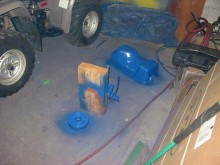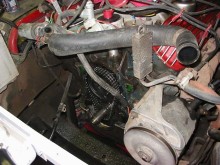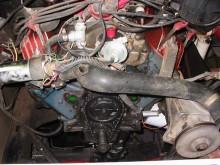|
This tech article is intended as advice only, and should not be used in
substitution of any correct manual, instructions, or specifications. There is
potential for loss of property, injury, or even death if done incorrectly. If
you are uncomfortable with the swap, it is best to have a certified mechanic
work on your vehicle. Basically, I don't want to be responsible for anything
that could go wrong while doing this swap: by using this information, you are
doing so at your own risk, and agreeing that I cannot be held responsible for
any damages, injuries, or other acts of god that may occur.
The first step is to gather everything you will need:
- New timing chain
- Gaskets for water pump, timing chain cover, and front of oil pan (should be
included with timing chain cover)
- Basic hand tools (wrenches, screwdrivers (good for prying old gaskets), pry
bar, and rubber mallet.
- Harmonic balancer puller
- Coolant
- Motor oil
The second step is to set the motor at TDC (Top Dead Center). An easy way to
do this is to remove a spark plug for cylinder #1, place a screw driver in it,
and carefully bump the motor over (with the coil wire grounded) until the
screwdriver just starts to fall back down. A turn of the harmonic balancer will
return it to exact TDC.
The third step is to remove everything that may be in your way during the
installation. It will take a lot more time trying to fight around things then to
simply remove them, out of your way, the first time. This includes your fan,
alternator, power steering, and any other brackets or systems that may be in the
way. It is also a good idea to remove the radiator. It may be possible to
install a new chain with the radiator still in place, but once again, it will
take more time fighting with it then it would to simply remove it. Go ahead and
do a coolant change at them time; its cheap and easy.
Once you have drained all the coolant from the radiator, and removed any
objects that may intrude into the working space, it is time to remove the water
pump. The water pump is held on by a series of 7 bolts 1/2 bolts. Once removed,
you can move onto the harmonic balancer.
The harmonic balancer will take a special tool (called a harmonic balancer
puller) to be removed. Before you attack the puller, makes sure you have
loosened the large bolt holding it in place (in the center of the harmonic balancer). Once you are ready, place the
puller in position, filling at least 3 holes with the correct size bolts.
Sometimes a longer bolt will allow you more room to position it into place. Make
sure that all bolts are the same length before pulling the blanacer.
After the harmonic balancer has been removed, you can remove the timing chain
cover. There are only a few more bolts holding the cover in place. Make sure you
get the bolts connected to the oil pan.
*NOTE: You are going to get coolant into your oil. No matter how careful you
are; it will happen. Be prepared to change your oil after you do this
swap.
At this time, you should be able to inspect your current timing chain. This
timing chain had an unknown amount of miles on it, but it was definitely worn
out. Notice the slack at free stand, and with tension:
I then used a pry-bar to remove the old chain. Very carefully pry back and
forth on the top sprocket. Keep the tension even on each side, and the chain
will slowly work its way off the shaft. Keep sliding the chain in unison, top to
bottom, until it is free to move with your hands. Once removed, it is a good
idea to inspect your cam-block, check for play in the cam, and other basic maintenance
items.
Before installing the new timing chain, I decided to paint everything a nice
bright blue color again. I chose to remove my entire oil pan, in order to
replace it with a new pan, and fix a leaking oil pan seal. You do not have to
remove your entire pan, although now would be a good time to replace the gasket:

Once you have painted everything, it is time to install the new timing chain.
I would recommend using a very liberal amount of assembly lube for this process.
It will help the chain on initial startup, and makes sliding the chain into
place a lot easier. Carefully position the chain in place with both marks lined
on the sprockets. The mark on the top sprocket should line up directly with the
mark on the bottom sprocket, with the top sprocket mark in the lowest position,
and the bottom sprocket mark in its highest position. If they will not line up
correctly, your cam may be out of line with the crank. In order to fix this, you
will have to adjust the cam until the marks line up. My engine was already very
close, so I did not have to move the cam in any direction.
 
Using the same principle as removing the old chain, carefully start tapping
the new chain into place with the rubber mallet. Make sure you do not bind the
chain, and be very careful to move the lower sprocket in sync with the upper
sprocket. Once it will go no further, check that it has remained in line, and
check tension. Obviously, this was a huge improvement over the previous chain:
Now it is time to install everything you removed. Only use new gaskets,
although a small dab of gasket-maker around the water ports is a good idea. It
is also a good idea to use a small dab of gasket-maker around the front seal of
the oil pan, where the oil pan dips for the front seal.
Return the harmonic balancer to position. Carefully tap it as far as it will
go. Use a torque wrench to snug it back in place, following the manufacture's recommendations.
Continue bolting the water-pump into place, and finally bolt all accessories
back in their locations. Return the fan, radiator, and prepare to start. Don't
forget to change the coolant and oil at this time. After you start, be sure to
check and adjust timing to the correct manufacture's specifications.
Tech article by Mike Dodd (md_lucky_13)
|



